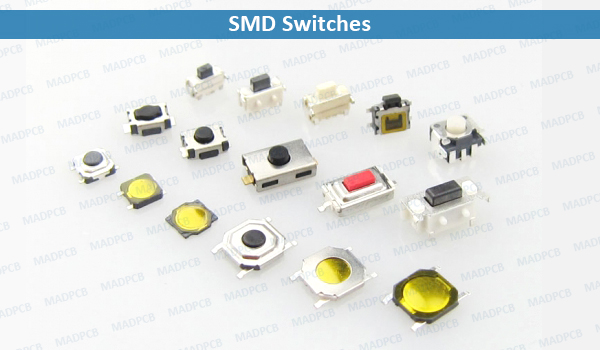What’s A Switch?
A Switch is an electrical component used to control a circuit by either close (ON) or open (OFF) the circuit. When it is turned on, the circuit is complete. When it is turned off, the circuit is broken. Ideally having zero impedance when closed and infinite impedance when open.
There are many types of PCB switches, including push button, toggle switch, rotary switch, PCB switch and etc. Surface mount (SMD/SMT) switches are designed to place flat directly on top pads of a PCB. Through-hole (or thru-hole) PCB switches are inserted into a drilled and plated-through hole (PTH) on the printed circuit boards (PCBs) and soldered to pads on the opposite side.
What’s A PCB Switch?
A PCB switch is a type of electrical switches, which is characterized by the use of a printed circuit board. The term “PCB” even refers to “printed circuit board”, which is the primary feature driving this switch’s popularity. They are produced using a printed circuit board as the underlying circuitry powering the switch’s mechanism.
Benefits of PCB Switches
While there are other types of electrical switches available, many businesses — and even some consumers for that matter — prefer PCB switches.
- For starters, PCB switches allow electricity to flow with less resistance. They are made of highly conductive materials, such as copper, to provide a lower level of electrical resistance.
- If you’re looking to purchase a switch for outdoor use, you can’t go wrong with PCB. Unlike most other switches, PCB switches are able to withstand harsh and extreme environments, including the outdoors.
- PCB switches support plating options as well. You can choose gold-plated PCB switches, for example, that feature a plated layer of gold.
- PCB switches even support backlighting, allowing for a deeper level of customization. The most common backlighting solutions used in PCB switches include light-emitting diodes (LEDs), light guides, electroluminescent (EL) and fiber optics.
- Furthermore, PCB switches support multiple soldering methods, including hard soldering as well as epoxy-based soldering.
Printed circuit boards have been around for decades. Recent technological advancements, however, has improved their design and overall performance. So, if you’re shopping for an electrical switch, consider a PCB switch to take advantage of the benefits listed above.

